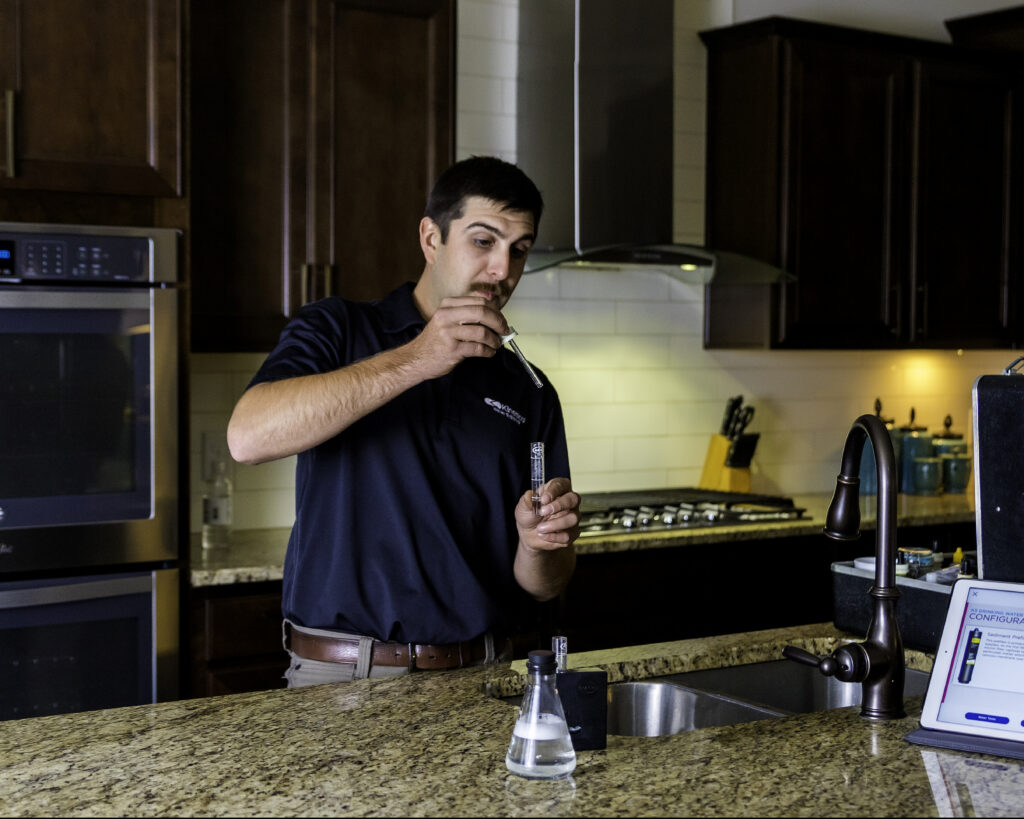There’s a lot that can be learned from your water when making tea. To take the test, please heat up two glass mugs of water, one with untreated Tap Water and the other Kinetico Treated Water. Insert tea bag and steep for five minutes before removing the tea bags. You will see the Kinetico difference in the untreated water and the Kinetico treated water from the color of the tea alone.
The difference in color is coming from the metals and inorganic particles in your tap water, including calcium, magnesium, potassium, sodium, bicarbonates, chlorides and sulfates. These particles are known as total dissolved solids (TDS). With your Kinetico system, your water will be free of natural and man-made impurities giving your family that looks and tastes superior.
What is TDS and TSS in water? These particles, or ‘solids’, can be divided into two types by passing the water through a filter. The particles that are large enough to be held back by the filter are called total suspended solids (TSS), while the particles that pass through the filter are called total dissolved solids (TDS).
Water Filters don’t remove Important Minerals from your Water
Studies have found that minerals in your drinking water make essentially no contribution to your health and may even be present in forms your body can’t absorb. Minerals in an inorganic state flow through our systems versus minerals in an organic state that are readily absorbed by our bodies. You are much better off maintaining a balanced diet that provides you with an adequate supply of important vitamins and minerals.
However, for those who do want to add healthy mineral into their drinking water, or if you’d just prefer the flavor of water with a bit of mineralization, we offer the Mineral Plus Flexfiltration cartridge which can be included in the Kinetico K5 Drinking Water Station.
Features of the K5 Drinking Water System
- 99% Contaminant Removal: The K5 significantly reduces more contaminants than any other drinking water treatment unit. The K5 is certified by WQA to NSF/ANSI Standard 58 for PFOS/PFOA removal.
- QuickFlo® Technology: The K5 features QuickFlo® technology to deliver a strong, steady stream of high-quality water when you want it. Fact is, the K5 produces more water faster than any other comparable system so you won’t need to ration or wait for your water.
- Purefecta Protection: No other water treatment system provides you with as much protection against arsenic, nitrates, lead, fertilizers, pesticides, chlorine, taste, odor and a host of other contaminants. Improve your protection by adding the Purefecta Virus/Bacteria Guard, which reduces greater than:
- 99.99% of viruses
- 99.99999% of bacteria
- 99.999% of protozoa/cysts
- Customizable, Multi-State Filtration: You can customize the FlexFilters in your K5 according to the specific water challenges you’re facing now or that you may encounter in the future.
- EverClean® Rinse: Thanks to EverClean® Rinse, the K5 uses high quality water to clean itself which keeps the system in top working order and extends the membrane’s life.
- Consumers Report Best Pick!
Why Water Testing is Important

Water quality can no longer be taken for granted. There are many variables that can come into play: the possibility of contaminated water, our aging water distribution system, unknown well-water quality and the type of plumbing in your home. Many don’t realize it’s common for municipalities to supply you with hard water too. If your home has water supplied by the city, it probably meets federal standards, but are those standards your standards?
Whether your home’s water is supplied by a municipality or a private well, it is important to understand what is and isn’t in your water. By having your water tested, you will learn about the quality of your water, if any contaminants are present and what water treatment options are available to improve your water.
Public water treatment facilities work very hard to ensure your city water is safe to drink. Unfortunately, some contaminants may be difficult to detect or treat realistically on a large scale. And after the water leaves the treatment plant, contaminants can also enter the water system through gaps in the infrastructure or from aging pipes.
Private water sources, or wells, have their own challenges and need extra attention and precautions. Since a private well’s water quality is at risk when the water comes in contact with naturally-occurring and man-made contaminants, it needs to be regularly tested to ensure it’s safe to drink.








Some filters only remove certain minerals. The filters are designed to remove unwanted impurities from water, but not all of the impurities in water. It is important to use a reliable filter, or find another source for water to be safe.